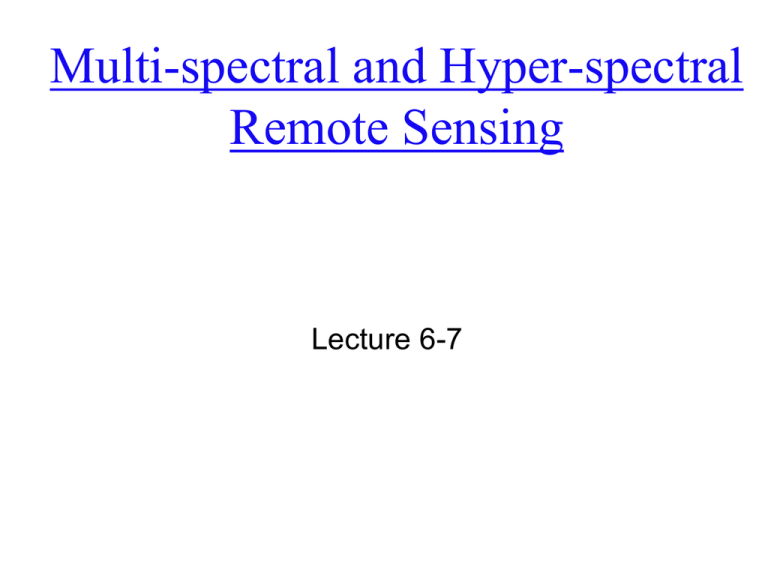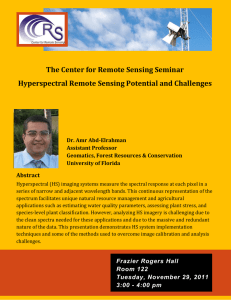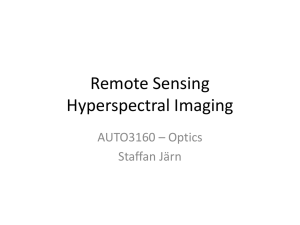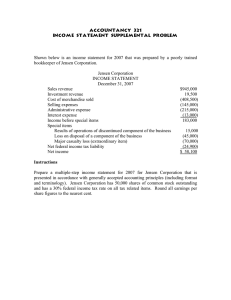Multi-spectral and Hyper-spectral Remote Sensing Lecture 6-7
advertisement

Multi-spectral and Hyper-spectral Remote Sensing Lecture 6-7 Multispectral Remote Sensing Multispectral remote sensing is defined as the collection of reflected, emitted, or backscattered energy from an object or area of interest in multiple bands of electromagnetic spectrum; while Hyperspectral remote sensing involves data collection in hundreds of continuous bands with spectral resolution of ≤ 20nm. Instead of cameras and 1 to 4 bands for photogrammetry, Remote sensing use detectors that are sensitive to from multiple bands to hundreds of bands in the electromagnetic spectrum. Measurements made by detectors are always stored in a digital format (as BSQ, BIP, or BIL) Ustin, 2003 Landsat satellite series MSS 0.5-0.6 0.6-0.7 0.7-0.8 0.8-1.1 10.4-12.6 TM 0.45-0.52 0.52-0.60 0.63-0.69 0.76-0.90 1.55-1.75 10.4-12.5 2.08-2.35 79m 240m 30 120 6 bits 8 103 m/c 99 18 days 16 919km 705 185km 185 ETM+ 0.45-0.52 0.52-0.61 0.63-0.69 0.78-0.90 1.55-1.75 10.4-12.5 2.09-2.35 0.52-0.90 30 60 15 8 99 16 705 185 Jensen, 2000 Inclination (99º) of the Landsat Orbit to Maintain A Sun-synchronous Orbit Sun-synchronous orbit mean that the orbital plane processed around Earth at the same angular rate at which Earth moved around the Sun The satellite cross the equator at approximately the same local time (9:30 to 10:00 am) Orbit the Earth once every 103 minutes, resulting in 14 orbits per day. Landsat at 12:30 p.m. local time N MSS 99º TM 98.2º 99Þ Equatorial plane and direction of Earth rotation Landsat at 9:42 a.m. local time Jensen, 2000 S Today’s Landsat 7 orbits and acquisition http://landsat7.usgs.gov/pathrows.php You can download Landsat images from this website for anywhere in the world. It is free. You can check the cloud coverage, the quality of an image and time series of images for any place. GOES satellites provide the kind of continuous monitoring necessary for intensive data analysis. They circle the Earth in a geosynchronous orbit, which means they orbit the equatorial plane of the Earth at a speed matching the Earth's rotation. This allows them to hover continuously over one position on the surface http://www.oso.noaa.gov/goesstatus/ GOES13, or GOES-N Launched 5/24/2006 GOES14, or GOES-O Launched 6/27/2009 GOES15, or GOES-P Launched 3/4/2010 http://www.oso.noaa.gov/goesstatus/ GOES http://antwrp.gsfc.nasa.gov/apod/ap050829.html GOES data downloading http://www.class.ngdc.noaa.gov/saa/products/search?datatype_family=GVAR_IMG IFOV =1.4 milliradians, 833 km above surface 100 Normalized Relative Response (%) 80 Band 2 80 60 60 40 40 20 20 0 500 550 100 600 650 700 Wavelength (nm) 750 0 600 800 700 800 900 Normalized Relative Response (%) 80 60 60 40 40 20 20 3.6 3.5 3.7 Wavelength ( 1100 Band 4 80 3.4 1000 100 Band 3 0 3.3 Advanced Very High Resolution Radiometer (AVHRR) Bandwidths 100 AVHRR Band 1 3.8 m) 3.9 4.0 0 9.5 1.1 km 10 10.5 11 11.5 12 100 Band 5 Normalized Relative Response (%) 80 60 40 20 0 11 11.25 11.5 11.75 12 12.25 12.5 Wavelength ( m) Jensen, 2000 Advanced Very High Resolution Radiometer (AVHRR) Mosaic of the Conterminous United States Jensen, 2000 Global Normalized Difference Vegetation Index (NDVI) Image Produced Using Advanced Very High Resolution Radiometer (AVHRR) Imagery Jensen, 2000 Chronological Launch History of the SPOT Satellites Jensen, 2000 SPOT Satellite System Components Courtesy of SPOT Image, Inc. Jensen, 2000 Geographic Coverage of the SPOT HRV and Landsat Thematic Mapper Remote Sensing Systems Jensen, 2000 IKONOS Panchromatic Images of Washington, DC Jensen, 2000 1 x 1 m spatial resolution IKONOS Panchromatic Stereopair of Columbia, SC Airport Jensen, 2000 November 15, 2000 IKONOS Imagery of Columbia, SC Obtained on October 28, 2000 Panchromatic 1 x 1 m Pan-sharpened multispectral 1 x 1 m Earth Observing System Terra – AM (launched 12/18/1999) Multi-angle Imaging Spectroradiometer (MISR) Onboard Terra 70.5Þ Da 60Þ Ca 45.6Þ Ba 26.1Þ Aa 0Þ nadir 26.1Þ Af 45.6Þ Bf 60Þ Cf Nadir is the point of the Earth surface that is vertically downward from the observer 70.5Þ Df Sens ors Df View an gle 70.5Þ Cf 60Þ Bf 45.6Þ Af An 26.1Þ 0Þ Aa Ba 26.1Þ 45.6Þ Ca Da 60Þ 70.5Þ 425 – 467 nm 543 – 571 nm 660 – 682 nm 846 – 886 nm 275 x 275 m 1.1 x 1.1 km f: forward, a: after 275 m x 1.1 km Jensen, 2000 Terra launched 12/18/1999 Earth Observing System Aqua – PM (launched 5/4/02) mission is collecting about the Earth's water cycle, including evaporation from the oceans, water vapor in the atmosphere, clouds, precipitation, soil moisture, sea ice, land ice, and snow cover on the land and ice. Additional variables also being measured by Aqua include radiative energy fluxes, aerosols, vegetation cover on the land, phytoplankton and dissolved organic matter in the oceans, and air, land, and water temperatures The six instruments are - AIRS: the Atmospheric Infrared Sounder - AMSU-A : the Advanced Microwave Sounding Unit, - HSB: the Humidity Sounder for Brazil , - AMSR-E: the Advanced Microwave Scanning Radiometer for EOS, - MODIS: the Moderate-Resolution Imaging Spectroradiometer, and - CERES Clouds and the Earth's Radiant Energy System. Information about Terra: http://terra.nasa.gov/ and Aqua: http://aqua.nasa.gov All Terra and Aqua and many other data can be downloaded from: http://edcimswww.cr.usgs.gov/pub/imswelcome/ Earth Observing System Aura (launched 7/15/04) The Aura mission researches the composition, chemistry and dynamics of the Earth’s atmosphere as well as the ozone, air quality and climate. The six instruments are - HIRDLS: HIgh Resolution Dynamics Limb Sounder - MLS : Microwave Limb Sounder - OMI: Ozone Monitoring Instrument - TES: Tropospheric Emission Spectrometer Information about Aura: http://aura.gsfc.nasa.gov/index.html NPP Satellite Scheduled for Launch Nadir facing antennas – T&C – HRD – SMD Launch Readiness Date: October 25, 2011 VIIRS CrIS ATMS OMPS http://jointmission.gsfc.nasa.gov/ 45 NPP Goals The NPP mission has two major goals: To provide a continuation of the EOS record of climate- quality observations after EOS Terra, Aqua, and Aura (i.e., it will extend key Earth system data records and/or climate data records of equal or better quality and uncertainty in comparison to those of the Terra, Aqua, and Aura sensors), and To provide risk reduction for JPSS instruments, algorithms, ground data processing, archive, and distribution prior to the launch of the first JPSS spacecraft (but note that there are now plans to use NPP data operationally) 49 Hyper-spectral remote sensing Many remote sensing systems record energy over several separate wavelength ranges at various spectral resolutions. These are referred to as multi-spectral sensors. Advanced multi-spectral sensors called hyperspectral sensors, detect hundreds of very narrow spectral bands throughout the visible, near-infrared, and mid-infrared portions of the electromagnetic spectrum. Hyper-: Narrow bands ( 20 nm in resolution or FWHM) and continuous measurements. Imaging spectrometry: the simultaneous acquisition of images in many relatively narrow, contiguous and/or non-contiguous spectral bands throughout the ultraviolet, visible, and infrared portions of the spectrum. The very high spectral resolution facilitates fine discrimination between different targets based on their spectral response in each of the narrow bands Source: http://satjournal.tcom.ohiou.edu/pdf/shippert.pdf Airborne Visible Infrared Imaging Spectrometer (AVIRIS) Datacube of Sullivan’s Island Obtained on October 26, 1998 Jensen, 2000 Linear and Area Arrays Hyperion (EO-1, NASA) 220 bands: 400-2500 nm, band width 10 nm Pixel size 30 x 30 m, swath width 7.5 km 11/21/2000 to present, it is the first satellite-based hyperspectral remote sensor. Science information: http://eo1.gsfc.nasa.gov/overview/eo1Overview.html Data order from: http://edc.usgs.gov/products/satellite/eo1.html Hyper- and Multi- spectrum comparison TM image Band 1 to Band 7 123 4 5 7 0.6 average shrub 0.5 average grass Reflectance average soil 0.4 0.3 0.2 0.1 0 250 500 750 1000 1250 1500 1750 2000 2250 2500 Wavelength (nm) Continuous hyperspectral curve for any one pixel in an image Ustin, 2003 Summary table: current and recent hyderspectral sensors OMEGA ESA Mars Express 351 Spectral resolution: 7 or 4 nm in 0.5-1.1 microns 13 nm in 1.0-2.7 microns 20 nm in 2.6-5.2 microns Spatial resolution: 300 m – 5 km 0.35 to 5.12 µm (8 to 12.5 µm) Cont’ Hyperspectral sensors on Mars orbit TES -- Thermal Emission Spectrometer (s. r. 3Km ), on board the Mars Global Surveyor, 1997, NASA (will be covered in the Thermal Remote Sensing lecture) OMEGA -- Visible and Infrared Mineralogical Mapping Spectrometer (s. r. 0.3 - 4Km), on board the Mars Express, 2003, ESA CRISM--Compact Reconnaissance Imaging Spectrometer for Mars (s. r. 18 m), on board the Mars Reconnaissance Orbiter, 2005, NASA What is OMEGA ? OMEGA - Visible and Infrared Mineralogical Mapping Spectrometer 352 contiguous spectral bands Covering 0.35 to 5.1 µm Spectral resolution of 7 nm to 20 nm Spatial resolution of 0.3 to 4 km/pixel Surface mineralogy revealed by OMEGA Mafic and ultramafic minerals (pyroxene and olivine) Surface CO2 and H2O ice and frosts Hydrated sulfates (gypsum, kieserite, and polyhydrated sulfates) on light-toned layered terrains Hydrated alteration phyllosilicates (nontronite, chamosite, and montmorillonite) Iron oxides and oxhydroxides (hematite and jarosite) related to liquid water processes From: Bibring et al. 2005; Mustard et al., 2005; Poulet et al, 2005; Gendrin et al. 2005; Langevin et al, 2005; Arvidson et al, 2005; Combe et al, 2005. all in Science vol. 307 Identification of Olivine (J. F. Mustard et al., 2005) Yellow - OMEGA I/F of Terrain A Red - OMEGA I/F of Dusty Terrain Blue - lab spectra of Fe-rich olivine (Fayalite) Green - lab spectra of Mg-rich olivine (Forsterite) Black - ratio of (Terrain A)/(Dusty Terrain) Red - olivine absorption-band strengths > 10% Blue - no olivine detected with this parameter http://crism.jhuapl.edu/ CRISM False Color R:2.50µm G:1.50µm B:1.08µm Louth Crater Band Depth Extraction





